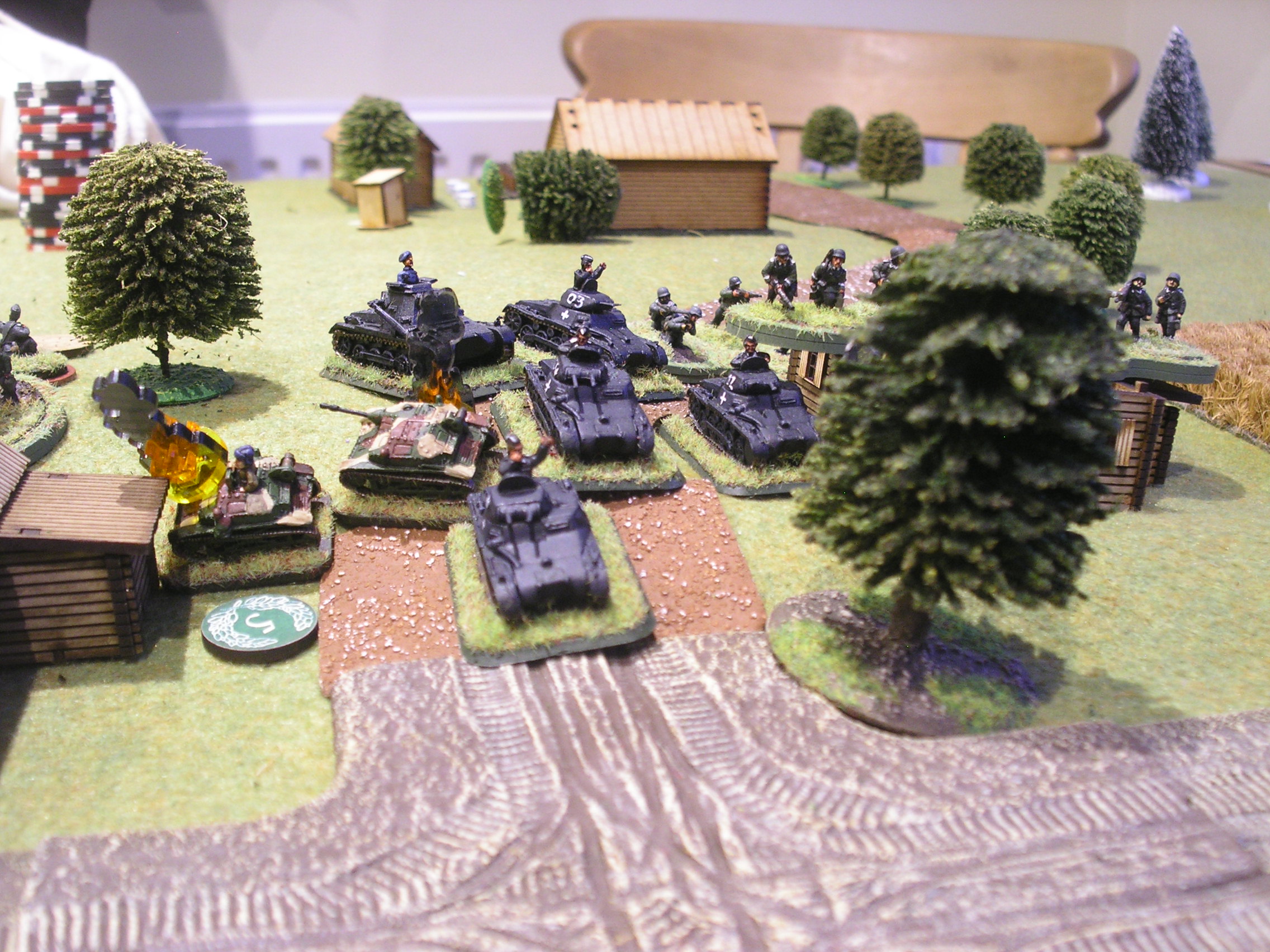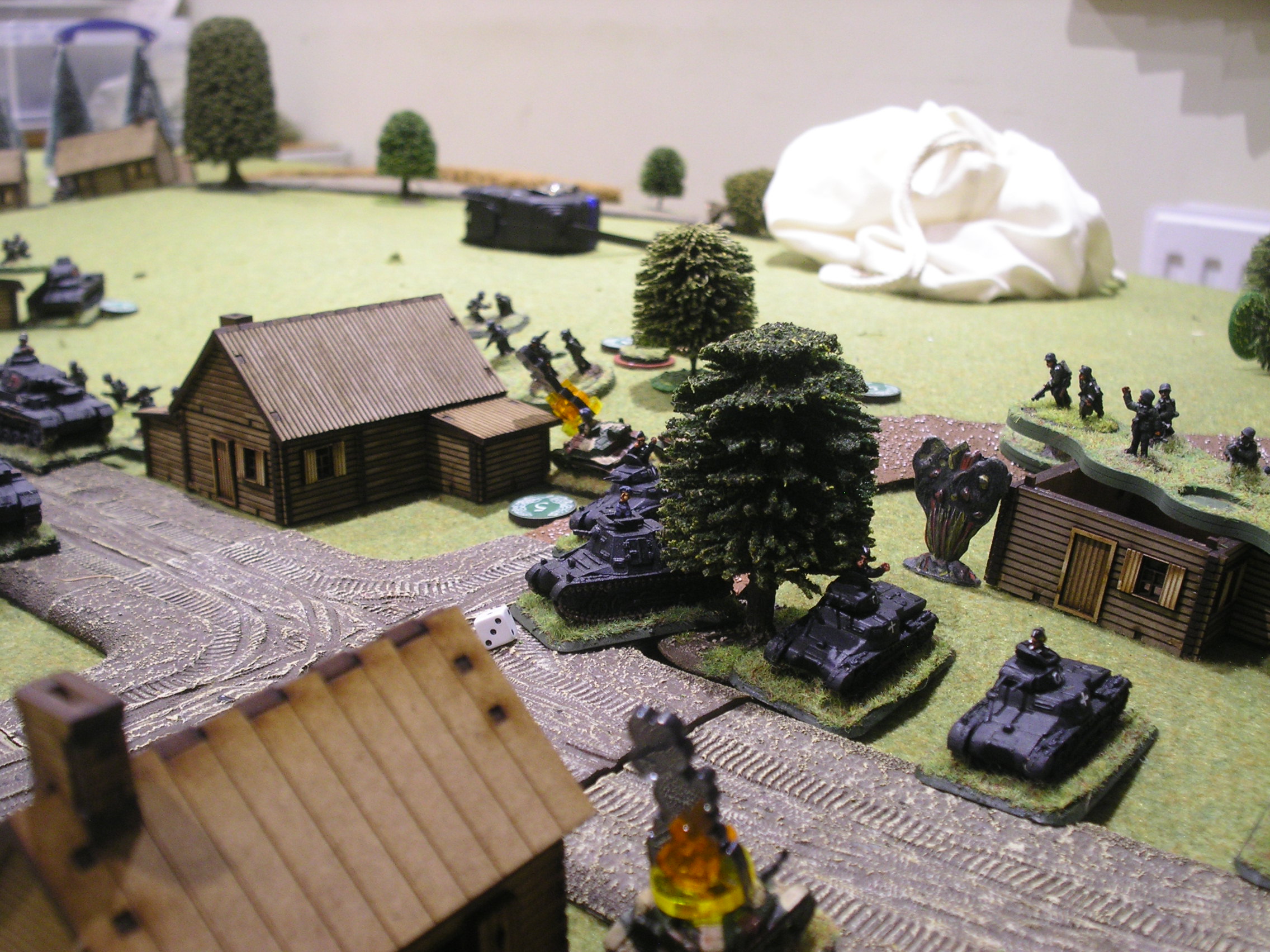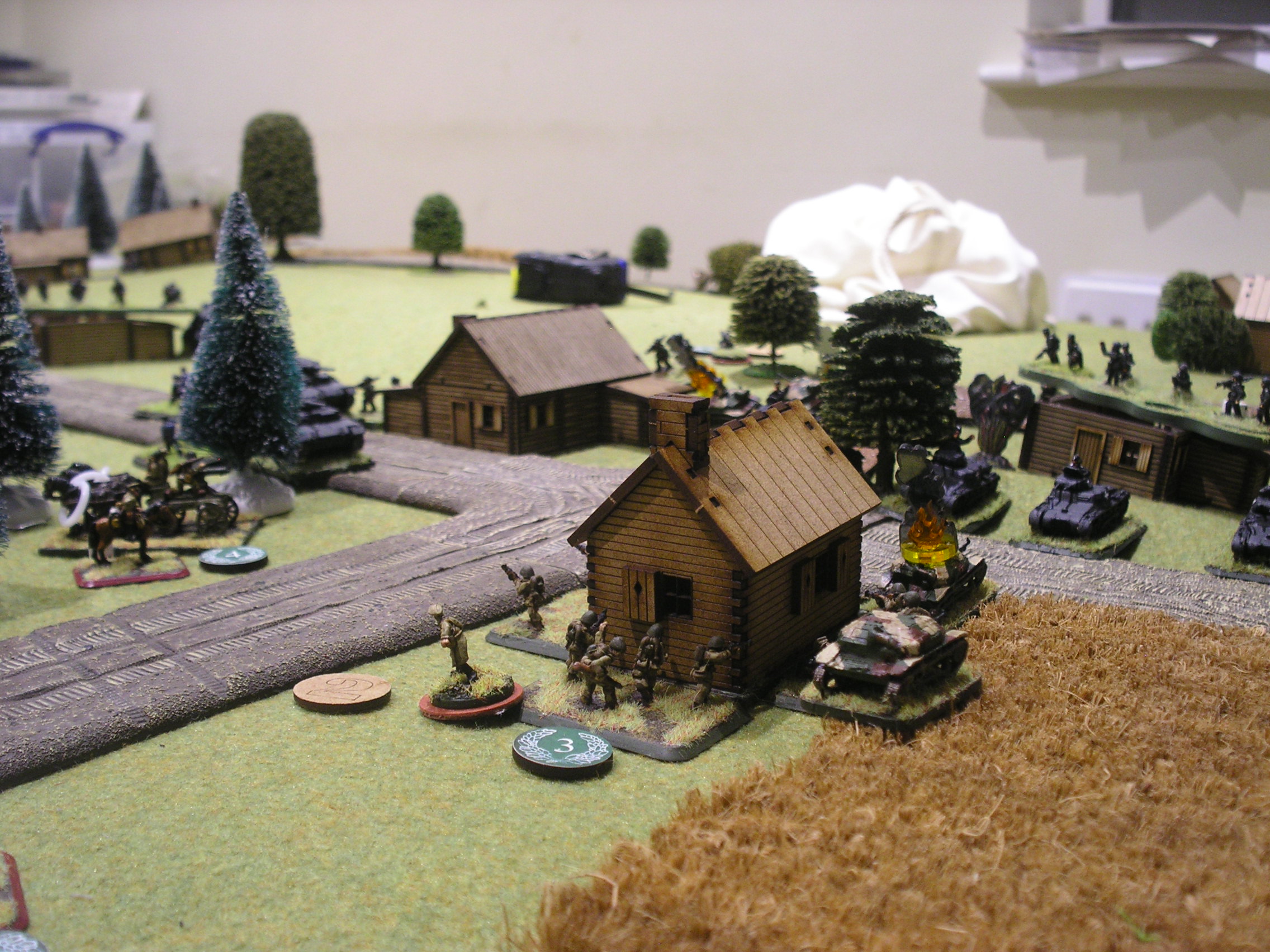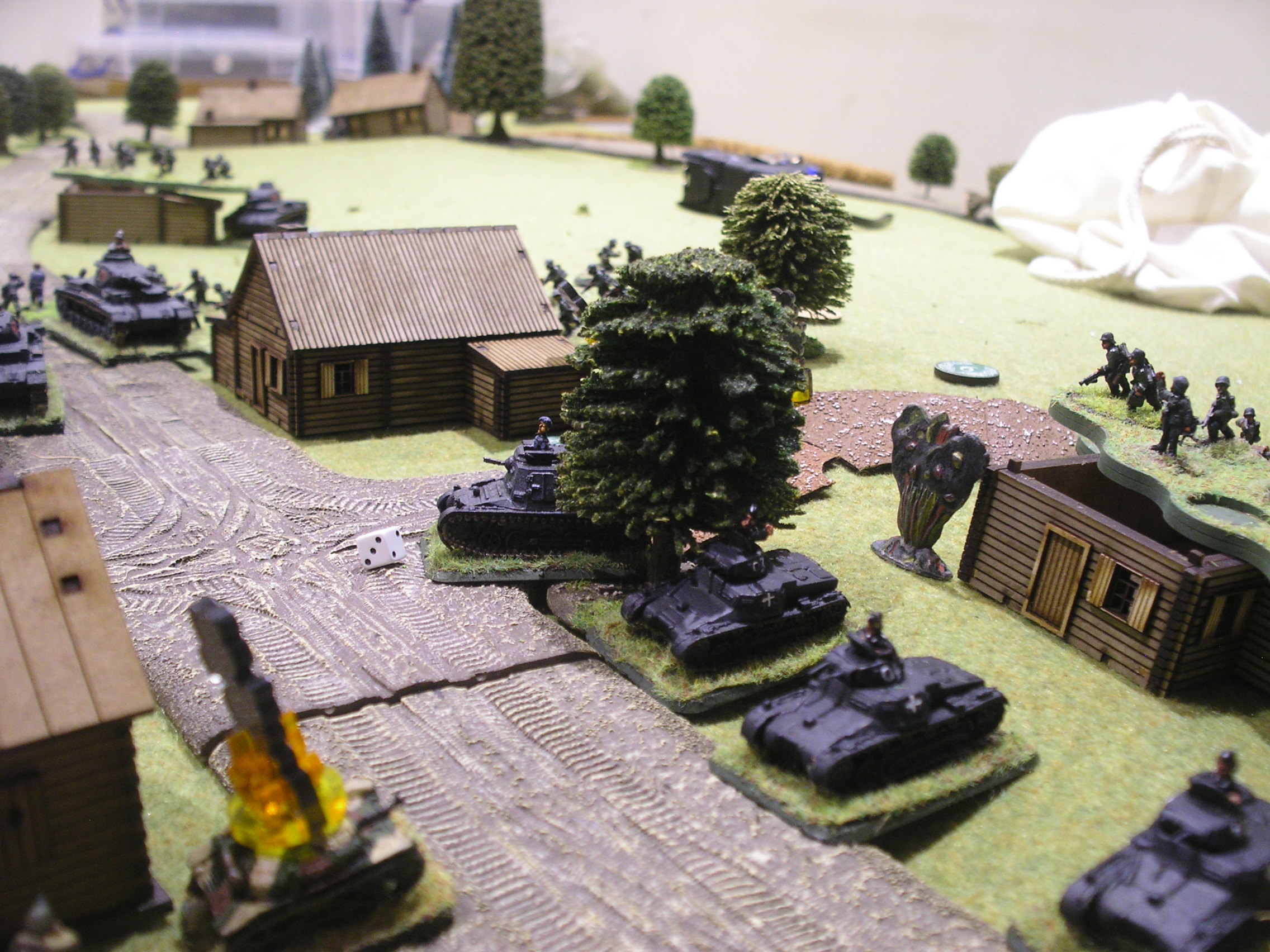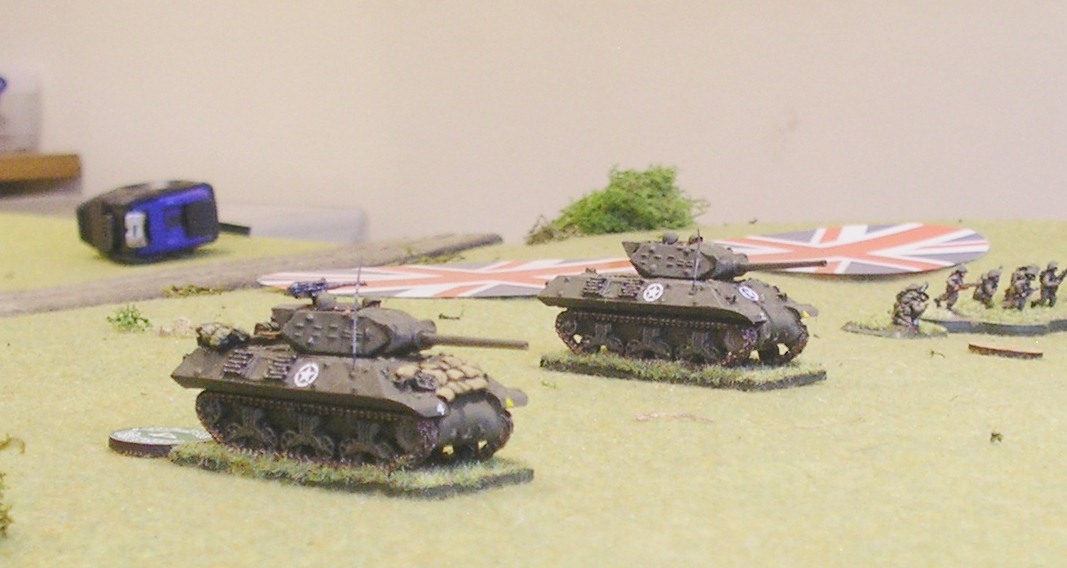"Sacre bleu!" Serge Krotoff cursed under his breath as the staccato retort of an MG34 reached him through the clear February air, "les Sovietiques!". They had arrived too soon. Looking back down narrow Pomeranian farm road the Obersturmfuhrer cast his eye over the half a dozen anti-tank guns that should already be in Barkenfelde. He signalled to his driver to pull over to allow the huge 88mm guns to take the lead, followed by the smaller, but still deadly, Pak40s. If they could make the crossroads by the brewery before the Reds then they could still form a Pak-front and try to stop the enemy there.
In Barkenfelde Hauptsturmfuhrer Rene-Andre Obitz looked southwards in horror. A veteran of the eastern front – he had fought with the Legion Voluntaires Francais since 1941 - he was used to the sheer mass of a Soviet advance, but this was different. Only one company of his battalion were in position and the promised anti-tank guns had not arrived. His men had only a thin ration of panzerfausts with which to confront the Soviet armour that was now advancing from the south, bristling with the small figures of what he knew would be he tough sub-machine gun armed troops who would spearhead any attack.
"Ou est la plume de ma tante?" He called for his adjutant to bring forward the pen his aunt had given to him in the heady days when the LVF lay before the gates of Moscow. With no telephone system in place a hand-written note would have to suffice to warn headquarters of the Soviet present. Carefully he formed the letters, "la giraffe est très grande, le pingouin est très petite", it was a simplistic code but would have to suffice.
As he wrote the tearing sound of an MG42 broke to clear silence on this frosty day. In the chateau two nervous gunners opened fire, attempting to sweep the tank riders from their mounts. Obitz spat, fools! The range was too long. Only moments were required before the retort of several 85mm guns boomed across the flat, snow-strewn landscape, with an almost instantaneous explosion as their shells hit the target with an accuracy that was proven by the desultory fire that now came from what Obitz had hoped would be a strongpoint of resistance.
From his position at the southernmost farm in Barkenfelde Rottenfuhrer Thiery Chirac's palms were clammy despite the cold. Again he checked his panzerfaust as he squatted behind the neat garden wall. He could hear the cries of the Soviet tank riders – drunk, as always. This would be a close call. To fire too early would be to waste the two anti-tank weapons that his squad desperately needed to score an early victory that might buy some time. Too fire too late….with the Soviets only yards away, that would be certain death. Chirac did not want to die; his dreams of a centre-stage role in a united Europe were too strong. He nodded to the Sturmmann at his side. Two projectiles shot forward towards the leading Soviet tanks, for a moment he could hear the cries of the tank riders as they leapt down, but Chirac was not waiting to see if the `fausts hit home or not, "Vite!" he cried, and scampered back with his squad northwards through the warren of farm tracks.
Yefreitor Ivan Putinovsky leapt from the T34-85. his SMG firmly in his grasp despite the vodka he had consumed. The laughing would stop now, Fritz was putting up a fight. The two projectiles swept high above the tank before dipping to explode on the banks of the swirling icy brook that ran parallel to the road. Ivan motioned to his men and ran forward into the farm cottage where he was certain that the shots had come from. He kicked the door in, his machine gun spitting death, but the tiny dwelling was empty. Still, that clock on the mantelpiece would look good in his home near Tomsk. Was there anything else worth taking?
Starshy Leytenant Igor Blimie frantically signalled with his flags from the turret of his T34-85. His first platoon was to advance line abreast up the main road, supported by his second platoon. The third platoon of tanks was to swing out to the left to attempt to cross the frozen fields and enter the village from the west. Any delay would see him in trouble with his superiors. Igor knew all too well the price of failure in the Soviet Union.
Serge Krotoff was now riding with the lead Pak43. As they crossed the field to the north side of the brewery the veteran of SS Sturmbrigade Frankreich signalled to Oberscharfuhrer Johnny Halliday to deploy his Pak 40's across the main road north. Krotoff was moving his 88's round to cover the western entrance to the village. The stream that rand on the eastern side of the main road was only narrow, but it was fast moving and deep. He could rely on this to stop any Soviet armour crossing. So now he had his Pak-front, covering the only two entrances to the village. It wasn't ideal, the guns had no cover other than what snow they could scrape to form an impromptu breastwork, but at least they were in position.
Igor Blimie was nervous. He knew exactly what desperate Germans could achieve with their anti-tank weapons. His tanks stood, scanning the small village before them, and his tank riders dismounted and ran forward. "Clear those buildings" he called to Mladshy Leytenant Yevgeny Primakov as the young officer ran forward with his men.
Oberscharfuhrer Lucienne Hennecart watched as Rottenfuhrer Chirac ran back past his position. "Courgage, mes braves" he hissed. He could see the advancing Soviet infantry now, hot on the heels of Chirac. Some had entered the small farm cottage that neighboured the farm he was holed up in, but they were clearly busy inside. Loot probably, the civilian population had been moved out yesterday to Hammerstein. But now a fresh wave was coming on. "Attente, attente" he steadied his men until the Soviets were within yards, and then a cacophony of sound greeted the Slavic looking men in brown, the front rank went down, but more came on. Frantic hands sought to throw grenades into the small outbuildings that Hennecart's men were holding, here and there Frenchmen went down whilst more Soviets came up to take the place of the dieing and dead.
The sound of the 88mm gun was the first warning that the crew of the T34 had of the enemy's presence in the garden of the cottage to the western side of the village. Not that they could do anything about it, as the shell tore through the frontal armour of their tank and exploded amongst them, throwing the turret twenty yards clear of the blazing wreck. Death was instantaneous. A second retort, then a third. In seconds two Soviet tanks were blazing. In a panic Starshina Boris Yeltsin swung his tack to the right and headed in towards the village – anything to get away from those monstrous guns. The other remaining tank in his platoon followed him with similar thoughts.
Lucienne Hennecart looked round. Two men left from his squad, and the Soviets were coming back for round three. He looked for a line of retreat, but two Soviet tanks were racing in from the west, across the field to cut off his line of retreat. Seizing a panzerfaust he dropped to one knee, oblivious to the cries from his left as the Soviet SMG troops came on, cutting down his lat two men. At a range of less than fifteen yards Lucienne fired the panzerfaust, striking the side of Starshina Yeltsin's tank. The explosion knocked the Frenchman from his feet, just in time to him to see a Russian jackboot come crashing down onto his head. Whether he heard the shots from the PPSH that ended his life is questionable.
Igor Blimie waved his flag with gusto. On went his tanks, now confident of sweeping Fritz before them. Amid the tanks more dismounted SMG troops ran forward, keeping apace with the advance.
Oberscharfuhrer Johnny Halliday looked down the sighting mechanism of the Pak 40 at the looming shape of the T35. He sang quietly to himself, "Souvenirs, souvenirs" but what memories he was conjuring up none around him could be sure – perhaps his time in the Milice in Nice. "CRASH", Halliday's gun opened fire, prompting the rest of the gunners to do likewise. Two T34s were hit in the first tirade of fire, both damaged, both still fighting.
Shots were traded now, tank gunner against anti-tank gunner. Blimie, hesitant before, was invigorated as the adrenalin of battle course through his veigns. "Davai, davai" he yelled, and the tanks rolled forward.
In the centre of the village was the farm Barkenfelde, after which the settlement had been named some four hundred years previously when the Germans came to the area. Its large imposing farmhouse and extensive outbuildings were now a strongpoint of German resistance. Rottenfuhrer Chirac had sought sanctuary here when he withdrew from his outlying position early in the fight. With two MMGs mounted in the upstairs windows he felt confident enough to stand his men down for a smoke break. But Yevgeny Primakov was no respecter of breaks.
The one remaining T34 from the third platoon had now moved forward through the smoke that billowed from Yeltsin's tank. It pumped round after round into the large Germanic farmhouse, seeming to spit hate at such a symbol of German dominance that had come with the Teutonic Knights. Under the cover of the smoke Primakov looked around. Ahead of him Yefreitor Putinovsky was crouched in the farmyard (complete with a large clock and what appeared to be a sink, complete with taps), to his left another squad was moving up through the field. "Comrades, for Mother Russia, follow me. Uhraaaah!". The cry was taken up by twenty mouths, and then more. A wave of humanity, smelling strongly of cheap tobacco, swept forward.
In the manor house, on the far side of the stream, a German squad lay in wait as the T34s advanced past them into the heart of the village. They could see now that one Pak 40 had been knocked out in the churchyard, but more were still firing from the far side. The one remaining MMG that had lain silent since the long range exchange of shots was ended by several well placed 85mm shells early in the battle now opened up, pinning down the Soviet infantry that were following the tanks forward. A burly NCO stepped up, nonchalantly chewing on a sausage before discarding it and firing his panzerfaust across the stream. "Merde!" he cursed as it missed its target. Seizing another he tried again, but this was not his day. Another miss.
In the farmhouse Chirac was alerted to the fresh threat by the cries of the machine-gunners as they frantically sought to hold back the Red tide that was now seeking to engulf them. Rushing into the farmhouse he was just in time to see a large Soviet junior officer break in through the front door and fire his SMG upwards through the wooden first floor. The cries of the MG42 crews above left Chirac in no doubt as to their fate. The Rottenfuhrer slipped back into the courtyard and signalled swiftly to his men to retire. The brewery would now be the last line of defence.
Panic now swept through the ranks of the French anti-tank gunners under Halliday. No amount of singing could help them now, and shot after shot missed their target as the advancing tanks came on. Men who had fought for four years "contre les bolshevisme" now saw their nemesis before them.
Serge Krotoff had not allowed his early successes to lull him into a false sense of security. He had called forward a prime mover and dragged one of his 88's forward to face the oncoming Soviet second tank platoon. Again his gun had sent the crew of more tanks to whatever Godless Valhalla Soviet warriors aspire to. The western edges of the village were secure again, as tankers edged back into the covering smoke.
On Krotoff's left Scharfuhrer Jacques de Villepan had watched from a row of cottages as the Barkenfelde farmhouse had been taken by the Reds. Now he unleashed a torrent of fire into the building. He knew that Unterscharfuhrer Aznavour still held the main barn in the farmyard, and that a counter-attack could restore the line.
Putinovsky was shocked by the sheer volume of fire that now seemed to shake the elderly farmhouse. Plaster fell about him as the walls seemed to disintegrate under the punches of hundreds of unseen giants. Around him men turned to jelly, all fight drained from them. And now a diminutive SS man was leading a counter-attack, his squad sweeping into, guns chattering their deathly song. But Putiniovsky was not done yet. Thrusting one arm into the slot where a shattered beam would normally secure the sturdy oak door, the Soviet officer used the other to hurl grenades into the oncoming SS men. His men rallied around him.
All war is terrible, but this fight between the short French Unterscharfuhrer and the giant of a Soviet Junior Lieutenant was Hell itself. His arm crushed and broken the Russian still secured the door, his men falling around him the Frenchman hacked and lunged, gouged and bit his way into the farmhouse until, finally, the Soviet hero was overcome. The victory was as phyrric as it was short-lived. The next wave of Soviet infantry swept in, overrunning the exhausted Frenchmen with ease. "Adieu Cherie" were Aznavour's last words as he fell to the bayonet of a Siberian rifleman.
And now the first of the Soviet tanks was in amongst the Pak 40's, crushing first one then another beneath its tracks. Halliday rallied his last crew temporarily, destroying another T34 at a range of less than six foot, before being killed as a tank exploded as a panzerfaust crashed into it from the brewery.
Rene-Andre Obitz wept as the inevitability of his position was clear. Krotoff was already limbering up his two remaining 88's, and de Villpan would stay in position for just long enough to cover the retreat. But now Soviet trucks were unloading their fresh troops, ready to sweep through the village. To linger would invite death. SS Charlemagne had been bloodied, and some would say defeated. But the burning hulks of a dozen T34-85s told a story of desperate heroism in the face of overwhelming odds. And tomorrow they would fight again.
A great fun game last night on Lard Island, it was the first of the three scenarios in the 2006 Festive Sack Full that cover the fighting in Pomerania at the end of February in 1945. It is actually a huge scenario, with three Soviet tank platoons, each with a supporting platoon of tank riders, supported by three more rifle platoons in trucks. On the German side the original scenario calls for three platoons at the start of the game with six anti tank guns and two more platoons as reinforcements. As this was an evening game with only a couple of hours play I reduced the Soviet truck mounted infantry to just two platoons, and the German reinforcements were reduced by a platoon. Nevertheless it was a big (BIG!) game and we were very pleased to get a clear result by the end.
Tricky and BA played the French with gallic flair and aplomb. Noddy and Marvin played the Soviets. Noddy is actually ideal as a Soviet player, not only does he reside in a hut, smell of cheap tobacco and live off watery vegetable stew, he also knows the power of SMG troops and is not afraid of using them as a large sledgehammer. Which is exactly the right way to use them if you have numerical advantage.
In the event they tore into the French defenders and inflicted terrible losses. By the end of the game the Soviet armour had been torn to bits by a combination of panzerfausts and anti-tank fire, but it was the Soviet dominance in infantry, and their clear readiness to use them aggressively that meant that the French had to abandon what slim toe-hold they had left in the village.
Richard Clarke















